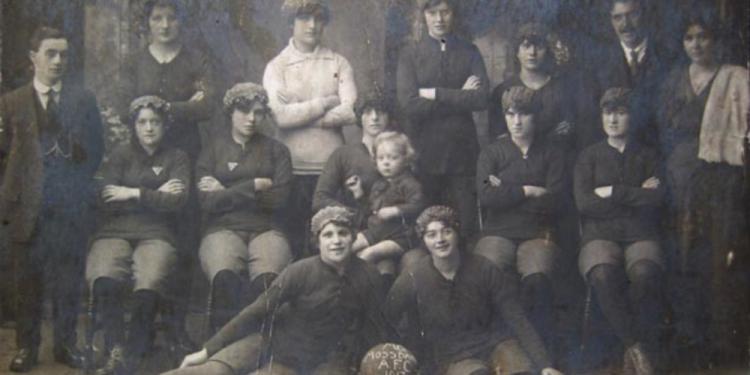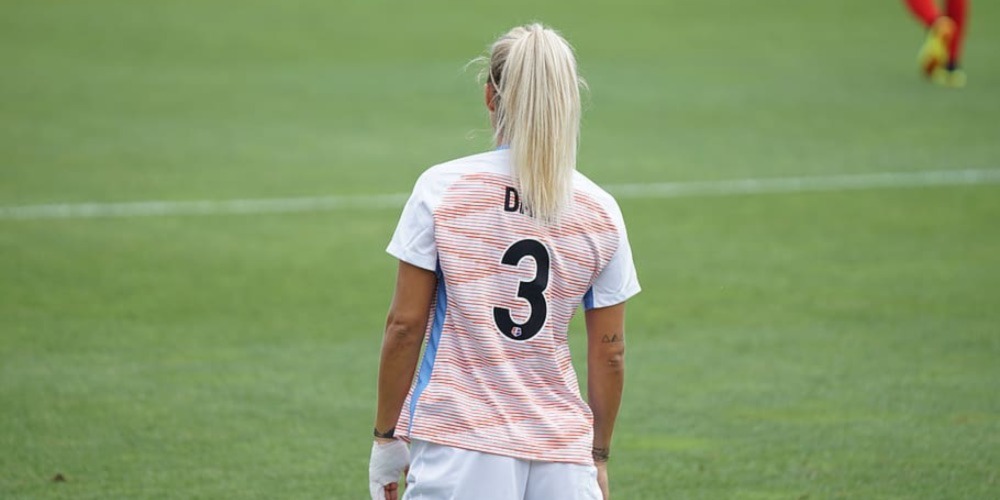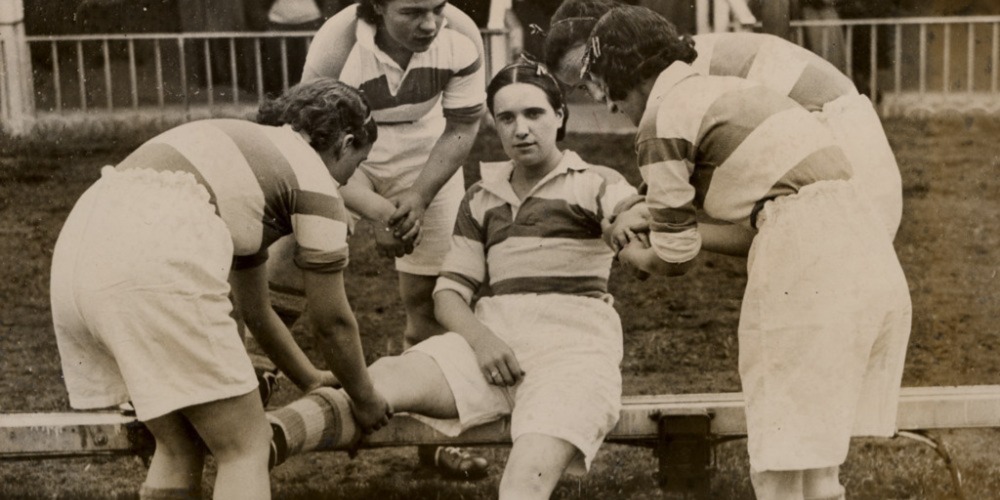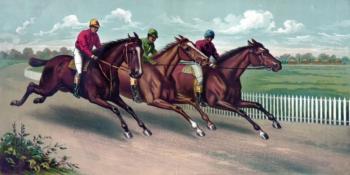The First-Ever Female Football Teams
Posted: February 20, 2023
Updated: February 20, 2023
-
Female footballers were harrassed and mocked at first
-
The most famous pioneers
-
Check out the difficulties the first-ever female football teams had to overcome!

The difference in popularity between women’s and men’s football is obvious, in terms of interest and finances to this day. However, there was a time when female football matches were more popular. By 1921, more spectators watched women’s football than men’s in England, mostly due to the First World War.
Today, football is still primarily dominated by men, but female players and teams are increasingly proving their determination, knowledge, and talent on the field. Women’s football had a long way before it could get to this point, and we are going to take a look at the first-ever female football team!
The Beginnings
The breakthrough of women’s football in England is closely related to the First World War, although its history goes back a long time. There are records of the first female matches similar to European football from the end of the 17th century. The history of these is also interesting. Year after year in Scotland, teams of married and unmarried women played against each other, which also served as an old dating app.
Besides the value of the sport, it had a matchmaking purpose. Single men went to watch the girls to see if they would make good wives based on their skills and, of course, looks. Later, they abandoned the matchmaking custom, and the modern form of football started to take shape. The first official women’s team was the British Ladies’ Football Club, the BLFC. They organized matches between amateur teams from the north and south of England for charity in the early 1900s, but people did not take them seriously at first.
Of course, this is not surprising, as women did not even have the right to vote back then. At the end of the 19th century and the beginning of the 20th, the spectators often mocked and insulted the players. Sometimes they were forbidden to even step on the field. Then a very slow progress began. Something similar happened in the Olympic Games too. You can also check out the perception and progression of female athletes in the Olympics!
The First-Ever Female Football Teams Were Harassed
The world’s first official yet amateur women’s football match was played in Edinburgh in 1881, but they considered the game more a spectacle than a sporting event.

Well-known theater impresario Charles Scholes needed money fast, so he put together two women’s soccer teams, one representing Scotland, the other England, to play a friendly match in front of paying spectators, who only paid to see an unusual show.
At the meeting, to the satisfaction of the local audience, the Scottish team won 3-0 and encouraged by the success, Scholes organized a match in Glasgow a week later. The second match ended badly as the majority of the five thousand spectators got bored after a while.
Many of them rushed onto the field and started harassing the players, and when the game ended, they angrily chased them. Scholes tried to organize a few more matches, but they ended in a series of similar incidents, so the general view became that women’s football was boring and pointless.
The First Real Match
Thirteen years passed before a determined suffragette, Nettie Honeyball, founded the world’s first women’s football club in London. Honeyball posted a newspaper ad in late 1894 seeking athletic ladies to form an all-female soccer team. Within a short time, there were enough applicants, mostly middle-class women, so they could create the first official association, named British Ladies’ Football Club. Besides playing, Honeyball became the manager and coach of the team.
She generated such publicity and interest that nearly ten thousand spectators showed up at the club’s first official match. It was a milestone for women. Even Scottish writer and women’s rights activist Lady Florence Dixie sat in the stands.
In 1895, at the meeting at Crouch End in North London, BLFC, without an opponent, the team had to play against itself. The players divided themselves into two teams, one representing the northern part of the city, while the other the southern region.
The former won the match 7-1, but the first three goals were own goals, as some inexperienced players, who had only been playing football for a few weeks, were so affected by the whistling and shouting of the audience that they took the ball in the wrong direction. Some of the audience, mostly males, jeered and taunted the players and laughed loudly at the sight of women wearing shorts, while others did not shy away from violence.
The First-Ever Female Football Teams Had it Hard at First!
The press did not help matters. Reporters described their play as a parody and a joke. They even made sarcastic comments about the appearance of the players. According to the articles, the female players disregarded the rules of etiquette by wearing male clothes on the field and went so far as to claim that they were not even beautiful enough.

Ignoring the hate, Honeyball organized a national tour for the team and played matches in various cities across Great Britain on fields used by men’s teams.
However, the audience’s interest dwindled drastically. Only a few hundred people watched most of the matches. So, they came up with a new idea. She organized a Scottish tour for BLFC, during which the association challenged men’s teams to friendly matches.
The audience, which was not really interested in women fighting against each other, this time got a first-hand look at the battle of the sexes, which was very popular at the time. In theory, it seemed like the perfect idea. However, in reality, it wasn’t.
The male players, just like the audience, felt their pride stung, so they did not make it easy on the ladies. At the very first game in Irvine, a scandal erupted when one of the male footballers deliberately collided with a BLFC player with great force, resulting in a black eye. Members of the women’s team were outraged and stopped the game before the disappointed crowd went crazy. Spectators rushed onto the field and surrounded the BLFC members, who could barely escape to the dressing room.
No More Battle of the Sexes!
A similar incident occurred after the match in Glasgow. The female football was on their way back to their accommodation from the field in a rented carriage, but when they left, an angry crowd of several thousand attacked the team and its escorts.
The angry mob threw stones at the carriages, which broke the windows, injuring several people, including the drivers, a policeman, and players. Soon after, in order to avoid similar incidents, they forbade women and men from playing football against each other.
Women’s Football Revived During the World War!
Women’s football, which was slow to develop, got another chance due to the first World War. The men went to the front to fight, and the women went to work in factories to help however they could. Lunch breaks offered the perfect opportunity to start playing soccer in the yard. Since young men were fighting at the front across Europe, most football teams were left without players. Since people needed entertainment during such hard times, many saw the solution in women’s football.
This is why the demand for women who can play football suddenly increased again. One of the first official and most successful women’s teams of the era consisted of female workers who often challenged their male colleagues to play football during their breaks.
Named after the factory, Dick, Kerr, and Co., they officially founded Dick, Kerr Ladies F.C in 1917. Alfred Frankland managed them and regularly challenged teams from other factories to match. People followed the games with great interest.
The proceeds went to charity, supporting war-wounded soldiers and their families. After the end of the war, Dick, Kerr Ladies F.C. not only remained but also stepped up, signing several talented young players, for example, Lily Parr, who was only 15 years old when she joined. People often refer to her as the best female soccer player of the first half of the 20th century. You can read more about her pioneer work below!
The First-Ever Female Football Teams Records
The world’s first international women’s football match was in 1920 when Dick, Kerr Ladies F.C. played against the French women’s national team at London’s Stamford Bridge. Even though they lost 2-1, many people followed the match, which ensured them a four-game tour in France.
The already extremely popular team also played many times back home. Their game against St. Helens Ladies in Goodison Park in Liverpool broke a record in 1920 because 53,000 paying spectators sat in the stands.
This number is surreal! The Goodison Park, now Everton Stadium, holds less than 40,000 people, and the number of 53,000 spectators was a record for 99 years in women’s football. In 2022, more than 91,000 fans attended the match between Real Madrid and Barcelona in Madrid, which is a new world record. You can check out the first-ever female football teams’ legacy at Bet365 Sportsbook!
No Ban Could Stop Them!
Despite their success, the following year, the British Football Association banned women’s football again, claiming that football was too dangerous for women since they had weaker physical abilities than men. However, Frankland did not give up! He continued to manage the Dick, Kerr Ladies F.C, only in an amateur status, which was also illegal. He arranged for them to go on a North American tour in 1922, and a year later, they played for the world championship trophy against the Scottish Ruthgerien Ladies.
Although the opponent won the match 2-0, Dick, Kerr’s management, suspecting fraud, demanded a replay, but they refused it. Despite this, the team advertised itself as the world champion on posters and advertisements. In 1926, they changed the name and continued playing as Preston Ladies F.C. until 1965. The ban remained in place for fifty years, until 1971, and only then did the association officially allow women to play football again in England.
Lily Parr: the Best Player of the 20th Century
Her older brothers introduced Lily to playing football, and her talent quickly surpassed her brothers. At 14-15, she was almost 180 cm tall, kicked the ball very hard, and knew no mercy on the court. Frankland noticed her when Parr played just the second game of her career against Dick, Kerr Ladies in 1919, at 14. He immediately offered a contract to Parr, who, at such a young age, was happy to say yes and signed with one of the best teams of the time.
Over the next two years, both Parr and the team gained unprecedented popularity. In her first season, Parr scored 43 goals. Most sources from the time praised her shooting force, and unselfish playing style, who could pass with flawless accuracy. Parr was a great ball player who scored most of the team’s goals. According to online sportsbook sites in the UK, during her 32-year-long career, she scored approximately 900-1000 goals.
The exact number is unknown, but according to a record, by the time she was named team captain in 1946, Parr had scored 967 of the team’s 3,022 goals and missed only five games over the years. By the way, Parr was a pioneer outside the field too. For instance, she asked for her payment in Woodbine cigarettes and was also openly gay in an era when she faced general discrimination. She was definitely ahead of her time.
Click here to try the best odds at bet365 Sportsbook












